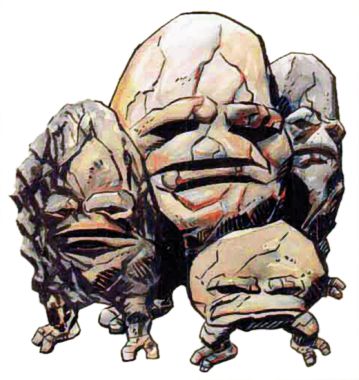

Monstrous Manual

| Climate/Terrain: | Any mountain |
|---|---|
| Frequency: | Very rare |
| Organization: | Family |
| Activity Cycle: | Day |
| Diet: | Special |
| Intelligence: | Very (11-12) |
| Treasure: | Q (×3),X |
| Alignment: | Neutral |
| No. Appearing: | 1-4 |
| Armor Class: | -2 |
| Movement: | 6 |
| Hit Dice: | 8-10 |
| THAC0: | 8 HD: 13 9-10 HD: 11 |
| No. of Attacks: | 2 |
| Damage/Attack: | 2-16, 3-18, or 4-24 |
| Special Attacks: | See below |
| Special Defenses: | See below |
| Magic Resistance: | 20% |
| Size: | L (8-12’ tall) |
| Morale: | Fanatic (17) |
| XP Value: | 8 HD: 8,000 9 HD: 9,000 10 HD: 10,000 |
The galeb duhr is a curious boulder-like creature with appendages that act as hands and feet. These intelligent beings are very large and slow-moving. They live in rocky or mountainous areas where they can feel the earth power and control the rocks around them.
A typical galeb duhr is from 8 to 12 feet tall. When not moving it looks like part of the terrain it lives in.
Combat: Galeb duhr are fairly solitary creatures, preferring to live with a few of their own kind, and none of any other kind, including earth elementals. When approached, a galeb duhr is liable to avoid the encounter by disappearing into the ground. If chased or otherwise irritated, however, a galeb duhr does not hesitate to fight the intruder.
Galeb duhr can cast the following spells as 20th-level mages, once per day: move earth, stone shape, passwall, transmute rock to mud, and wall of stone. They can cast stone shape at will.
They can animate 1-2 boulders within 60 yards of them (AC 0; MV 3; HD 9; Dam 4d6) as a treant controls trees. Galeb duhr suffer double damage from cold-based attacks and save with a -4 penalty against these attacks. They are not harmed by lightning or normal fire, but suffer full damage from magical fire (though they save with a +4 bonus against fire attacks).
Habitat/Society: Galeb duhr, thought to be native to the elemental plane of Earth, are sometimes encountered in small family groups in mountainous regions of the Prime Material plane. It is not known how (or whether) galeb duhr reproduce, but “young” galeb duhr have occasionally been reported – those specimens encountered being a smaller size than normal.
While galeb duhr seem to have no visible culture above ground, they are known to collect gems, which they find through their passwall ability. They sometimes have small magical items in their possession, evidently taken from those who attacked them to take their gems.
The “music” of the galeb duhr often provides the first evidence that these creatures are near – and usually the only evidence, as the unsociable galeb duhr are quick to pass into the ground when they feel the vibrations of approaching visitors.
Sitting together in groups, the galeb duhr harmonize their gravelly voices into eldritch tunes; some sages speculate that these melodies can cause or prevent earthquakes. Others argue that the low rumbling produced by these creatures is a form of warning to others in the group, but there is no conclusive evidence either way.
Ecology: Galeb duhr have no natural enemies, other than those who crave the gems they collect. Galeb duhr eat rock, preferring granite to other types, and disdaining any sedimentary type. The rocks they eat become part of the huge creatures; such a meal need take place only once every two or three months.
Besides the gems that they carry with them, galeb duhr are likely to know where many other gems are, as well as veins of precious metals, such as gold, silver, and platinum, though galeb duhr seem to have no interest in these minerals for themselves. A few powerful mages have been able to bargain with the galeb duhr for this information. This is a difficult agreement to consummate, for the galeb duhr are valiant fighters, and usually have no difficulty in escaping from any harm if they are inclined to do so. Further, the galeb duhr are territorial, and would be irritated at any attempt to make use of this knowledge in their vicinity.
In some strange way, galeb duhr feel responsible for the smaller rocks and boulders around them, in much the same way that a treant feels responsible for trees in its neighborhood. A traveler who disturbs the area near a galeb duhr does so at his own peril.
